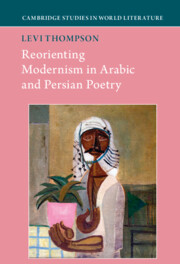Book contents
- Reorienting Modernism in Arabic and Persian Poetry
- Cambridge Studies in World Literature
- Reorienting Modernism in Arabic and Persian Poetry
- Copyright page
- Contents
- Acknowledgments
- Note on Transliteration
- Introduction
- Part I Crafting a Modernist Geography across Arabic and Persian Poetry
- Part II Imagining New Worlds
- Part III Aftermath
- Chapter 5 Honoring Commitments
- Chapter 6 Winter in the Modernist Garden
- Conclusion
- Notes
- Bibliography
- Index
Conclusion
Reorienting Modernism
from Part III - Aftermath
Published online by Cambridge University Press: 24 November 2022
- Reorienting Modernism in Arabic and Persian Poetry
- Cambridge Studies in World Literature
- Reorienting Modernism in Arabic and Persian Poetry
- Copyright page
- Contents
- Acknowledgments
- Note on Transliteration
- Introduction
- Part I Crafting a Modernist Geography across Arabic and Persian Poetry
- Part II Imagining New Worlds
- Part III Aftermath
- Chapter 5 Honoring Commitments
- Chapter 6 Winter in the Modernist Garden
- Conclusion
- Notes
- Bibliography
- Index
Summary
The title of Aḥmad Shāmlū’s November 1966 collection, Quqnūs dar bārān (Phoenix in the Rain), represents the stalled project of the earlier modernist poets, the postponed dream of rebirth. Shāmlū metaphorically represents the chilling rain of authoritarianism in his title, which puts out the Phoenix’s fire and stops the cycle of death and rebirth. We can extend this metaphor beyond the Persian context to the Arabic one as well, on the cusp of the Six-Day War and the psychological trauma that was to follow. Looking further into the future, Shāmlū also prophesies the ultimate failure of the Third World solidarity movement after the emergence of neoliberalism, which reordered the world system in the 1970s as the USSR fell farther and farther behind the capitalist Western powers. Shāmlū questions the real-world use value of a poetry that had, for the most part, failed to spur the masses to revolution, forcing the poet to become much more self-contemplative and move his gaze inward. In a continuation of previous modernist invocations of Christ (regarded in both the Arab and Iranian modernist traditions as a progenitor of the death-rebirth cycle), Shāmlū – ever so humble – puts the committed poet in the place of the Messiah in his poem “Marg-i Nāṣirī” (“The Death of the Nazarene”). As the executioners torture Christ (“‘Shitāb kun Nāṣirī, shitāb kun!’”; “‘Hurry up Nazarene, get on with it!’”), Shāmlū brings us back to Nīmā’s comparison of the poet and the swan in 1926’s “The Swan.” While the ungrateful crowd, including even Lazarus, stands aside in silence, Christ looks inward for strength as he dies. “Az raḥmī kih dar jān-i khvīsh yāft / sabuk shud / va chūnān qū-ī-’i / maghrūr / dar zulālī-’i khvīshtan nigarīst” (“[Christ] found peace / from the mercy in His soul / and like a proud / swan / He regarded His own purity”).1
- Type
- Chapter
- Information
- Reorienting Modernism in Arabic and Persian Poetry , pp. 165 - 170Publisher: Cambridge University PressPrint publication year: 2022

